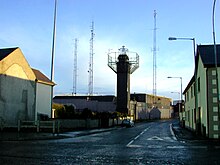Operation banner
The British military described a long-term deployment in the Northern Ireland conflict as Operation Banner . The declared aim was to save Northern Ireland from civil war. It began in 1969 and officially ended on July 31, 2007. Operation Banner was the longest of all operations by the British armed forces .
Beginning
When the riot in the province of Ulster (Northern Ireland) between the two denominations, Catholics and Protestants (Anglicans and Presbyterians), could no longer be contained by the Royal Ulster Constabulary , the Prime Minister of Northern Ireland, James Chichester-Clark , requested a military presence. The British troops were initially received and welcomed by the Catholic citizens as a protective power , as they hoped to end the attacks by loyalist extremists. But the mood soon turned. The soldiers were trained for combat missions overseas , not for peacekeeping work in the civilian environment at home. When the Provisional IRA and the Official IRA fought the army as an occupying power , the military tried to get under control of their opponent with raids and house searches. However, this rarely enough affected the IRA, but rather the uninvolved civilian population. The measures used became more and more disproportionate as the process progressed. The highlight was the deployment of British paratroopers on January 30, 1972 in Derry , the Bloody Sunday . After an initially peaceful demonstration, 14 Catholic Northern Irish were shot dead by British soldiers and numerous demonstrators injured.
strategy

What was planned as a short-term crisis response developed into continuous use for the military. Due to the chaotic conditions, withdrawal was out of the question, on the contrary, the troop strength continued to rise and finally amounted to 28,000 men. It became evident that massive military action alone could not pacify the province. There was a move to more closely monitor the IRA in order to be able to take more targeted action against them and not to turn the Catholic minority against them even more. Secret service activities became more important, so heavily fortified observation towers and road checkpoints were built everywhere in Ulster, which restricted the IRA's scope of action. A bitter guerrilla war ensued that would last over three decades and kill 763 soldiers, almost three times more than in the Falklands War . Infiltrated informants eventually brought IRA units in cities, such as the Belfast Brigade and Derry Brigade , to the brink of incapacity. However, the IRA units in the rural areas, such as the South Armagh Brigade and East Tyrone Brigade , proved to be stubborn and undefeatable opponents. Only towards the end of the 1990s, with the ceasefire of most paramilitary groups (exceptions: the splinter groups Continuity IRA and Real IRA still maintain the state of war) and the Good Friday Agreement, there was a real chance for a peaceful solution to the Northern Ireland conflict.
The End
As a confidence-building measure, IRA prisoners have been released from custody and the number of troops in Ulster has been continuously reduced. Maintaining safety on the roads increasingly passed to the reformed police force, the Police Service of Northern Ireland . Finally, as the clearest sign of pacification, the observation towers were dismantled and most of the army garrisons closed. There are currently 5,000 soldiers stationed in Northern Ireland, which are to be withdrawn gradually after the end of the operation.
An internal document by the British Army released in 2007 contained an advisory opinion that found that while the British Army failed to defeat the IRA by military means, they 'indicated to the IRA that they were not achieving their goals through violence '. The military rating describes the IRA as 'professional, dedicated, highly skilled and resilient'.